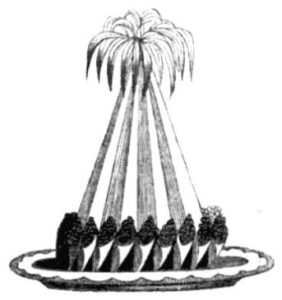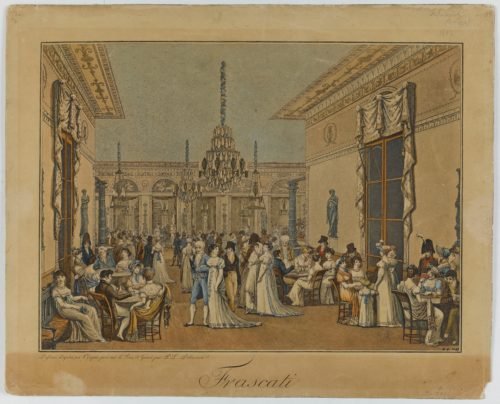Did Jane Austen Eat Ice Cream Cones?

Were ice cream cones really invented at the World’s Fair or did they originate much earlier, early enough that Jane Austen might have enjoyed one? Explore the history of ice cream cones with me.
Culinary mythology suggests that though Jane Austen enjoyed ice cream during her life, she would never have even conceived of an ice cream cone.
It is suggested that ice cream cones were an invention of an ice cream vendor at a fair (possibly the 1904 World’s Fair in St. Louis) in need of a way of serving their frozen treats. Who that ice cream vendor actually was and at what fair were they selling ice cream is a matter of some debate.

It does not take very long to fell that myth though. We know Italo Marchiony was granted a patent for a multiple cone mold on in December 15, 1903 so ice cream cones were clearly around before the 1904 fair.
But just how far back do ice cream cones go? That’s where it all becomes rather interesting.
Wafers

Wafers, the stuff of which ice cream cones are made, date to the medieval era where they were an important part of a meal’s end. Over the next few hundred years, they came to be regarded as “stomach settlers,” served at the end to the meal to calm digestion. Eventually—because creative cooks just can’t leave well enough alone don’t you know—wafers transformed into luxurious treats, making up an important element of the dessert course. Rolled into three-dimensional shapes called funnels, cornucopias, horns or cornets they could be filled with all sort of fruit pastes, creams, and iced puddings—and chocolate, we must not forget the possibility of chocolate!
The first printed recipe for wafer cones is found Clermont’s The Professed Cook from 1769.
Of Wafers and other Pastes.
What is here meant by Cornets (Horn), is the thin Dutch Wafers twisted like a Horn.
Des Gaufres.
Of Wafers.
The most fashionable are those made with cream. Mix as much powder-sugar as good flour, with a little orangeflower water-; put this into a proper vessel, and pour some good cream to it by little and little, stirring it very well with a spoon to hinder it from forming into lumps, and add as much cream as will make the paste or batter pour out pretty thick from the spoon. This is also made with Spanish, or sweet wine: mix an equal weight of sugar-powder and flour as before, and work it with one or two new-laid eggs, and sweet wine sufficient to make the batter of the same consistence as the first. They are also done with butter: use the flour and sugar as usual, add a little rasped lemon-peel, and a few drops of orange-flower water; mix as before by degrees, with very good butter melted in a little milk until it comes to the same consistence as others: the paste being prepared after this manner, of either kind, warm the waferiron on both sides, and rub it over with some butter tied in a linen bag, or a bit of virgin-wax; pour a spoonful of the batter, and bake over a smart fire, turning the iron once or twice until the wafer is done on both sides of a fine brown colour; if you would have them twisted, put them upon a mould ready at hand for that purpose; put it up directly as you take it out, and press it to the shape of whatever form you please, and so continue; always keep them in a warm place.
From Wafers to Ice Cream Cones
One might note that Clermont does not actually talk about what to do with those cones once they are made. That was left entirely to the cook’s imagination. It was not until Francatelli’s The Modern Cook (1846) more than seventy five years later, that we see a specific recommendation that these wafer shapes be used to hold ice cream. He recommended filling the wafer cornets with ice cream and using them to garnish ice cream puddings, including the rather spectacular creation Iced Pudding à la Chesterfield

ICED PUDDING, A LA CHESTERFIELD.
GRATE one pound of pine-apple into a basin, add this to eight yolks of eggs, one pint and a half of boiled cream, one pound of sugar, and a very little salt; stir the whole together in a stewpan over a stove-fire until the custard begins to thicken; then pass it through a tammy, by rubbing with two wooden spoons, in the same manner as for a purée, in order to force the pine-apple through the tammy. This custard must now be iced in the usual manner, and put into a mould of the shape represented in the annexed wood cut; and in the centre of the iced cream, some macédoine ice of red fruits, consisting of cherries, currants, strawberries and raspberries in a cherry-water ice, must be introduced; cover the whole in with the lid, then immerse the pudding in rough ice in the usual way, and keep it in a cool place until wanted. When about to send the pudding to table, turn it out of the mould on to its dish, ornament the top with a kind of drooping feather, formed with green angelica cut in strips, and arranged as represented in the wood-cut; garnish the base with small gauffres, filled with some of the iced cream reserved for the purpose, place a strawberry on the top of each, and serve. (Emphasis added)
Were their Ice Cream Cones in the Regency?

But I’m pretty sure that someone made the leap to use wafer coronets for ice cream in that seventy-five year gap between Cleremont’s book and Francatelli’s. In fact, near the end of the Regency era, in The Italian Confectioner (1820), G. A. Jarrin “wrote, that his almond wafers should be rolled ‘on pieces of wood like hollow pillars, or give them any other form you may prefer. These wafers may be made of pistachios, covered with currants and powdered with coarse sifted sugar; they are used to garnish creams; when in season, a strawberry may be put into each end, but it must be a fine’ . . . He suggested turning another of his wafers into ‘little horns; they are excellent to ornament a cream.” (Quinzio, 2000) Sounds like an ice cream filled cone to me!
Of course, that is only supposition, not concrete evidence. But fear not, we do have some tangible indication that ice cream cones might have been publicly consumed as early as 1807.
A colored engraving, titled Frascati, by Parisian Louis-Philibert Debucourt (1755-1832) published in 1807, depicted a Parisian café where at “small table in the right hand corner of the engraving with two ladies and a gentleman. On the table is a carafe and a glass, and the buxom lady facing us appears to be eating out of a cone which she is holding in her right hand. The gesture is modern and familiar to all of us ice cream cone consumers in the 2lst century: cone slightly tipped, mouth open for a lick. Anyone would recognize this as an ice cream cone.” (Weir, 2004)
So, did Jane Austen eat ice cream cones? We’ll probably never know for sure, and all in all, it is unlikely, but it is just possible that she might have.

What a delightful post. Thanks for giving us the link to that picture. Wow… that was a powerful portrait. I could see several things in that picture. That could be Darcy [who has turned away from her vulgar way of licking that cone] and Lizzy [back to us] and the buxom lady reminds me of Lydia. There is just something silly about her. Lawd, why on earth I thought of that…
I have recently been to Baskin Robbins but… I will admit… I asked for mine in a cup and not a cone. I may have to rectify that the next time I go in. It has been so disagreeably hot that I just didn’t want to deal with the mess and decided to cop out for the cup. You have made me hungry for that flavor combination of the cone with the ice cream. I knew something was missing. Thanks for this post.
I confess, I’m a sucker for ice cream cones. It’s hard for me to eat ice cream without a cone!